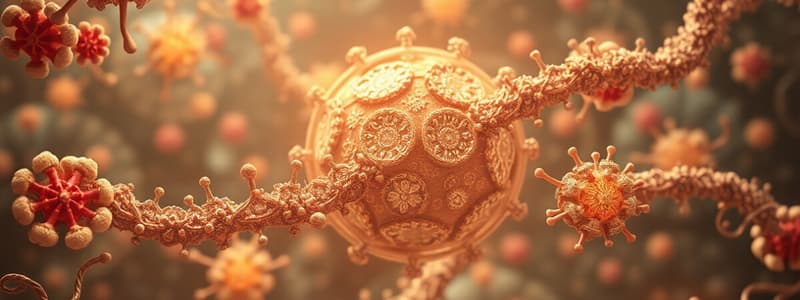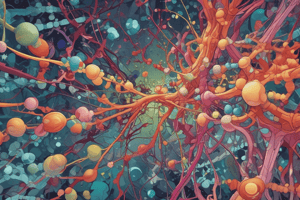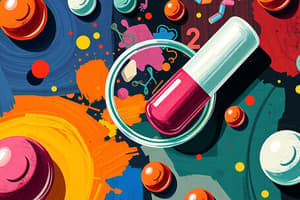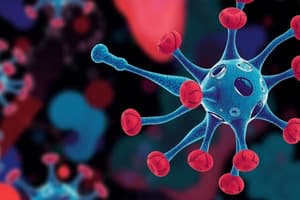Podcast
Questions and Answers
What is a likely consequence of increasing the dose of a drug?
What is a likely consequence of increasing the dose of a drug?
- Increased risk of targeting multiple receptors (correct)
- Immediate relief of symptoms
- Reduction in drug potency
- Decreased side effects
What is Emax in the context of pharmacology?
What is Emax in the context of pharmacology?
- The maximal response a drug can produce (correct)
- The average dose required for therapeutic effects
- The time taken for drug metabolism
- The minimum effective concentration of a drug
What are 'on-target' side effects?
What are 'on-target' side effects?
- Side effects that arise from the same receptor as the intended effect (correct)
- Side effects arising from different mechanisms
- Effects that are always desired
- Effects that are unrelated to receptor activity
Which receptor does diphenhydramine primarily antagonize?
Which receptor does diphenhydramine primarily antagonize?
Which statement accurately describes the relationship between potency and affinity?
Which statement accurately describes the relationship between potency and affinity?
Which of the following factors can influence a drug's potency aside from affinity?
Which of the following factors can influence a drug's potency aside from affinity?
What mechanism contributes to the drowsiness caused by dimenhydrinate?
What mechanism contributes to the drowsiness caused by dimenhydrinate?
What does EC50 represent in pharmacology?
What does EC50 represent in pharmacology?
What makes off-target side effects different from on-target side effects?
What makes off-target side effects different from on-target side effects?
In which scenario can a drug with low affinity still be considered potent?
In which scenario can a drug with low affinity still be considered potent?
What is the primary function of an antagonist drug?
What is the primary function of an antagonist drug?
If a drug has a higher affinity for its receptor, what is true about the value of KA?
If a drug has a higher affinity for its receptor, what is true about the value of KA?
What happens to the receptor when an agonist binds to it?
What happens to the receptor when an agonist binds to it?
What does the equilibrium constant KA signify in the context of drug binding?
What does the equilibrium constant KA signify in the context of drug binding?
When comparing two ligands, one being an antagonist and the other an agonist, what is true about their effects on the receptor?
When comparing two ligands, one being an antagonist and the other an agonist, what is true about their effects on the receptor?
What does it mean if the β value for an antagonist is 0?
What does it mean if the β value for an antagonist is 0?
What does the proportion of receptors occupied (P_A) equal when the drug concentration is equal to KA?
What does the proportion of receptors occupied (P_A) equal when the drug concentration is equal to KA?
Which statement correctly describes the relationship between binding and activation for most drugs?
Which statement correctly describes the relationship between binding and activation for most drugs?
What is depicted as a characteristic feature of drugs acting on a specific target?
What is depicted as a characteristic feature of drugs acting on a specific target?
What characteristic does Emax represent in dose-response curves?
What characteristic does Emax represent in dose-response curves?
What happens when the dose of a drug exceeds the maximal capability of the cell?
What happens when the dose of a drug exceeds the maximal capability of the cell?
What does the efficacy of a drug measure in terms of the drug-receptor complex?
What does the efficacy of a drug measure in terms of the drug-receptor complex?
In a dose-response curve, what is represented on the x-axis when plotted on a logarithmic scale?
In a dose-response curve, what is represented on the x-axis when plotted on a logarithmic scale?
What is indicated by a drug with zero efficacy in the context of agonist mechanisms?
What is indicated by a drug with zero efficacy in the context of agonist mechanisms?
What does an increase in drug concentration generally produce in physiological terms?
What does an increase in drug concentration generally produce in physiological terms?
What does the fluid level in a vessel represent in the context of a concentration-effect relationship?
What does the fluid level in a vessel represent in the context of a concentration-effect relationship?
What is meant by the term 'druggable genome'?
What is meant by the term 'druggable genome'?
Which of the following is NOT considered a protein target for drug binding?
Which of the following is NOT considered a protein target for drug binding?
Why are proteins considered ideal drug targets?
Why are proteins considered ideal drug targets?
What is the primary role of receptors in pharmacology?
What is the primary role of receptors in pharmacology?
Which of the following statements about drug targets is true?
Which of the following statements about drug targets is true?
What is a key challenge in drug target identification?
What is a key challenge in drug target identification?
What distinguishes receptors from other drug targets?
What distinguishes receptors from other drug targets?
Which of the following best describes the relationship between a drug and its target?
Which of the following best describes the relationship between a drug and its target?
Flashcards are hidden until you start studying
Study Notes
Drug Development and Efficacy
- A drug must target the right protein to be effective; incorrect pharmacological hypotheses can render a drug inefficacious.
- The "druggable genome" includes about 667 human proteins and additional human biomolecules with potential drug-binding capabilities.
Characteristics of Drug Targets
- Drug targets include receptors, enzymes, transporters, and ion channels.
- Receptors in pharmacology bind to endogenous signals; confusion exists between drug targets and receptors as non-protein targets (e.g., DNA, carbohydrates) are called drug targets.
Importance of Protein Targets
- Protein structure is crucial for discerning subtle differences in drug electronic structures for binding.
- Misallocation of drug effects can lead to side effects, especially when higher doses are required.
Specificity and Selectivity of Drug Interactions
- Lower potency drugs are more likely to have 'off-target' side effects, while 'on-target' side effects occur through the intended receptor.
- Diphenhydramine, a component of dimenhydrinate, antagonizes H1 receptors causing anti-emetic effects and muscarinic acetylcholine antagonism leading to drowsiness.
Binding and Activation of Receptors
- Agonists activate receptors upon binding; antagonists block activation without eliciting a response.
- Drug binding and receptor activation are reversible processes with different rate constants.
Affinity and Equilibrium Constant (KA)
- Equilibrium constant, KA, indicates the concentration at which 50% of receptor sites are occupied.
- Higher affinity drugs exhibit lower KA values, meaning less drug is needed to occupy receptors.
Concentration-Effect and Dose-Response Curves
- Biological responses to drug doses are measured in concentration-effect curves, revealing graded increases in response with dose increases.
- Maximum response (Emax) of a drug and the concentration for half-maximal response (EC50) provide data for comparing drug efficacy and potency.
Efficacy and Potency
- Efficacy (Emax) describes the maximal effect a drug can have; it distinguishes full agonists from partial agonists based on their ability to activate receptors.
- Potency relates to drug concentration; drugs with high potency often have high affinity but can vary due to factors such as receptor reserve and allosteric modulation.
Summary of Dose-Response Relationships
- Emax and EC50 values derived from dose-response curves allow for comparison of drug efficacy and potency, indicating the maximal biological effect and concentration for efficacy.
Studying That Suits You
Use AI to generate personalized quizzes and flashcards to suit your learning preferences.




